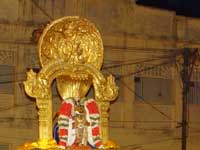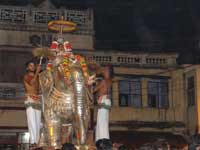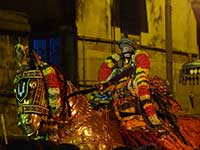About Srirangam Ranganathaswamy Or Srirangam Temple
Sri Ranganathaswamy temple, in Srirangam, is ranked above Tirupati, as the Number One shrine among the 108 Divya Desams. Srirangam is actually a 600-acre island-town, surrounded by the waters of the Cauvery on one side and its tributary, the kollidam, on the other. The gigantic temple of Sri Ranganathaswamy and his consort, Sri Ranganayaki, occupying 613,000 sq m (156 acres), is the pride of this island. The temple has a number f firsts to its credit, the latest being the 73m (240 feet) tall, 13-tiered Rajagopuram, built in the 1980s, said to weigh nearly 25,000 tonnes. There are 20 other gopurams in this temple complex, and as many shrines.
Although the early Sangam literature makes mention about this temple, the earliest extant inscriptions date back to the 10th century. Almost all the major dynasties that ruled this area, like the Cholas, the Cheras, the Pandyas, and the Hoysalas have contributed to make it the biggest temple complex in the country. However, the temple owes its present prominence to the Vijayanagar Empire and its successor, the Nayaks. There is a statue of Tirumala Nayak, the greatest of the Madurai Nayak rulers, sculpted on one of the pillars of this vast temple.
It is said that this is the only temple in India to have seven prakaras. The seven prakaras (enclosures), represent the seven centres of yoga the seven elements that make up the human body, at the heart of which is the soul. The seventh is the outer wall, more like a fort, built in the aftermath of the Islamic invasions. The Sri Venugopala Krishnan shrine is in the fourth court. The walls are adorned with carvings of women in various attire. There is also a museum here. To the southis the Sesarayar Mandapam, opposite to which is the 1000 pillared hall, which has exquisite sculptures of gods and goddesses, alwars and acharyas. In the first prakaram dwells the Lord in his famous reclining posture. The moolavar faces south. He goes by several names, though he is famously known here as Sri Ranganathaswamy.
The srirangam temple, as well as the Jambukeswaram shrine, suffered terrible blows during the Muslim invasions of the 14th century. The first one was in 1311 by that iconoclast general of the Khiljis, Malik Kafur. The second one was in 1323 under Ulugh Khan (the later Mohammed Bin Thuglak), the son of Ghiyasuddin Thuglak. The two Muslim raids crippled the temple to such an extent that worship ceased. The 1323 invasion was particularly devastating. Worship was restored only in 1371 invasion was particularly devastating. Worship was restored only in 1371 when the forces of Vijayanagar stormed the temple complex. From then on for the next 350 years the Vijayanagar kings and the Nayaks lavished their riches on the temple, which has been hailed as Bhooloka Vaikuntam (Heaven on Earth). Many are the savants and saints who have sung in praise of this deity.
At the rear end is the shrine of the divine consort, Sri Ranganayaki. There are a number fo shrines in the huge courtyard, including one for Sri Rama and another for Vibishana. A side entrance leads to another massive courtyard, at the end of which is yet another towering gopuram. The various vahanas for the annual Brahmotsavam are kept in a mandapam here. The pillars in the mandapam are rich with sculptures. The front of the mandapam is embellished with that Vijayanagar/Nayak specialty: horsemen fighting lions. So detailed are the sculptures that the craftsen have left nothing to the imagination. The carvings above and below this tapestry in stone are equally rich in detail. The base depicts women in various postures. One of the pillars shows a rider, with the horse reared up, while below are a number of foot soldiers.
According to the sthala puranam, following a quarrel between Ganga and Cauvery, Lord Vishnu agreed to rest on the banks of the Cauvery. Cauvery would be like a garland round his chest, He told her. Lord Rama, it is said, worshipped Sri Ranganathaswamy, and gave away Sri Ranganatha's image to Vibishana as his farewell gift. The idol, however, got stuck on the banks of the Cauvery . The Lord then disclosed to Vibishana the promise He had made to Cauvery. He consoled a distraught Vibishana saying that though He would not be coming with him to Lanka, His gaze would be towards the island. The Lord is stretched towards the east, and faces south, in the direction of Lanka. Behind Him are Kubera and Sri Lakshmi.
How to get there: Srirangam, only seven km from Trichy, is well connected by bus and rail. There is a station here, and most express trains stop at Srirangam before reaching Trichy Junction.
Accommodation: The temple runs a choultry, and there are private lodgings as well. Trichy offers more variety.
Srirangam Renganathaswamy Temple Photos |
 |
 |
 |
